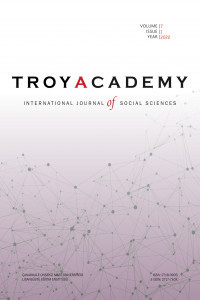Güney Çin Denizi Sorunu Çerçevesinde Çin-Hindistan İlişkileri
Malakka Boğazı vasıtasıyla dünya ticareti için
en önemli noktalardan biri olmasının yanı sıra zengin doğal kaynaklara sahip
olan Güney Çin Denizi, başta Çin olmak üzere, burada hak iddia eden Tayvan,
Vietnam, Kamboçya, Filipinler, Malezya ve Brunei arasında uzun süredir sorun
olmaya devam etmektedir. Güney Çin Denizi’nin önemi nedeniyle bu sorun küresel
bir boyut kazanmış ve ABD, Japonya gibi devletler de kendi çıkarlarını korumak
amacıyla soruna müdahil olmuşlardır. Son dönemlerde ise yükselen bir güç olan
Hindistan, özellikle Vietnam tarafından, Çin’i dengelemek amacıyla soruna dahil
edilmek istenmektedir. Bu bağlamda makalede; Çin-Hindistan ilişkileri ve Güney
Çin Denizi’ndeki sorunun gelişimi hakkında kısa bir bilgi verildikten sonra,
Güney Çin Denizi sorununa Hindistan’ın neden ve ne şekilde dahil olduğu, bu
durumun bölgesel dinamikler açısından önemi ve Çin-Hindistan ilişkilerine
yansımaları incelenmektedir.
Anahtar Kelimeler:
Malakka Boğazı, Güney Çin Denizi, Hindistan, Çin
___
- 2002 Declaration on the Conduct of Parties in the South China Sea, ASEAN, http://asean.org/?static_post=declaration-on-the-conduct-of-parties-in-the-south-china-sea-2 (17.06.2016). Agreement Between the Republic of India and The People’s Republic of China on Trade and Intercourse Between Tibet Region of China and India, Anlaşmanın tam metni için bkz. http://treaties.un.org/doc/publication/ unts/volume%20299/v299.pdf (01.07.2016) Arif, S. M. (2013). A History of Sino-Indian Relations: From Conflict to Cooperation. International Journal of Political Science and Development, Vol.1, no.4, 129-137. Ateba, B. (2002). Is the Rise of China a Security Threat? Polis, Vol.9, Numero Special. Bader, J., Lieberthal,K., ve McDevitt, M. (2014). Keeping the South China Sea in Perspective. The Foreign Policy Brief, Brookings. Bajpaee, C. (2013). Reaffirming India’s South China Sea Credentials. August 14, The Diplomat, http://thediplomat.com/2013/08/reaffirming-indias-south-china-sea-credentials/ (04.07.2016) Birleşmiş Milletler Deniz Hukuku Sözleşmesi. (1982). http://denizmevzuat.udhb.gov.tr/dosyam/denizhukuku.pdf (17.06.2016). Broderick, K. (2015). Chinese Activities in the South China Sea: Implications for the American Pivot to Asia. Project 2049 Institute. Burke, J. (2014). India and China Announced Trade Deals During Xi Visit to Delhi. The Guardian, http://www.theguardian.com/world/2014/sep/18/india-china-trade-deals-xi-delhi (01.07.2016) Buszynski, L. (2012). The South China Sea: Oil, Maritime Claims, and US- China Strategic Rivalry. The Washington Quarterly, Vol.35, No.2, 139-156. Cheng, R. (2010). Sino-Indian Relations:Sixty Years of Experience and Enlightenment. IPCS Special Report, 91, Institute of Peace and Conflict Studies, 1-10. China-India Trade Relations, Business Maps of India, http://business.mapsofindia.com/trade-relations/india-china/ (01.07.2016) Economy Watch. (2010). China’s Economic Relations. http://www.economywatch.com/international-economic-relations/ch (02.07.2016). Embassy of India. (2016). Economic and Trade Relations. http://www.indianembassy.org.cn/DynamicContent.aspx?MenuId=97&SubMenuId=0 (02.07.2016) Fravel, M. T. (2014). US Policy Towards the Disputes in the South China Sea Since 1995. Policy Report, S. Rajaratnam School of International Studies, 1-10. Glaser, B.S. (2015). The Growing Militarisation of the South China Sea. 29.07.2015, The Interpreter, http://www.lowyinterpreter.org/post/2015/07/29/The-growing-militarisation-of-the-South-China-Sea.aspx (25.08.2015) Grady, J. (2016). Expert: India, US Relationship with China Make ‘Hard Actions’ Difficult in South China Sea, Indian Ocean. 25 May, USNI News, https://news.usni.org/2016/05/25/expert-india-u-s-relationship-china-make-hard-actions-difficult-south-china-sea-indian-ocean (11.07.2016). India-China Bilateral Relations, Embassy of India in Beijing, China, http://www.indianembassy.org.cn/DynamicContent.aspx?MenuId=3&SubMenuId=0 (01.07.2016) Jian, Z. (2013). China’s Growing Assertiveness in the South China Sea: A Strategic Shift. National Security College, Australian National University, http://nsc.anu.edu.au/documents/occasional-5-brief-4.pdf (22.07.2015) Kissinger, H. (2012). On China, Penguin Books. Krishnan, U.; John . (2014). Vietnam Seeks India Role in China Sea as Dung Meets Modi. October 28, Bloomberg News, http://www.bloomberg.com/news/2014-10-28/vietnam-seeks-india-role-in-china-sea-spat-as-dung-meets-modi.html (04.07.2016) Lawrence, S. V. (2013). US-China Relations: An Overview of Policy Issues. CRS Report for Congress, Congressional Research Service, August 1, https://fas.org/sgp/crs/row/R41108.pdf (04.07.2016) Lunn, J. (2016). The South China Sea Dispute: January 2016 Update. House of Commons Library Majumdar, M. (2013). India’s Stakes in the South China Sea. International Journal of Humanities and Social Science, Vol.3, No.13, 242-247. Mearsheimer, J. (2001). The Tragedy of Great Power Politics, New York: Norton. Ministry of External Affairs. (2012). Government of India,”India-China Bilateral Relations”, https://mea.gov.in/Portal/ForeignRelation/China-January-2012.pdf (01.07.2016). Mitchell, D. J.; Bajpaee, C. (2007). China and India. in The China Balance Sheet 2007 and Beyond, (eds. C. Fred Bergsten, Bates Gill, Nicholas R. Lardy and Derek Mitchell), Washington D.C., Center for Strategic and International Studies and Peter G. Peterson Institute for International Economics, 151-70. Naidu, G.V.C. (2015). India, China and East Asia. in India and China in the Emerging Dynamics of Asia, (eds.G.V.C. Naidu, Mumin Chen, Raviprasad Narayanan ), Springer, 9-25. O’Rourke, R. (2014). Maritime Territorial and Exclusive Economic Zone (EEZ) Disputes Involving China: Issues for Congress, Congressional Research Service, September 26. Ohnesorge, H. W. (2016). A Sea of Troubles: International Law and the Spitsbergen Plus Approach to Conflict Management in the South China Sea. in Power Politics in Asia’s Contested Waters: Territorial Disputes in the South China Sea, (eds. Enrico Fels and Truong-Minh Vu), Springer International Publishing. Organski, A.F.K. (1968). World Politics. Alfred A Knopf, 2nd edition. Panda, A. (2014). India Considers China Import Duties. October 15, The Diplomat, http://thediplomat.com/2014/10/india-considers-china-import-duties/ (01.07.2016) Scott, D. (2013). India’s Role in the South China Sea: Geopolitics and Geoeconomics in Play. India Review, Vol.12, No.2, 51-69. Silva, A. H. L.; ve de Amorim, W. D. (2016). Australia, India and Japan: The Three ‘Worried Outsiders’ and Their Strategies Towards the South China Sea. in Power Politics in Asia’s Contested Waters: Territorial Disputes in the South China Sea, (eds.Enrico Fels and Truong-Minh Vu), Springer International Publishing. Sitaraman, S. (2016). Rising Chinese Power and Territorial Assertiveness in the South China Sea: India-Vietnam Strategic Partnership as a Counterbalancing Endeavor. in Power Politics in Asia’s Contested Waters: Territorial Disputes in the South China Sea, (eds. Enrico Fels and Truong-Minh Vu), Springer International Publishing. Thayer, C. A. (2010). The United States and Chinese Assertiveness in the South China Sea. Security Challenges, Vol.6, No.2, 69-84. Thayer, C. A. (2011). Chinese Assertiveness in the South China Sea and Southeast Asian Responses. Journal of Current Southeast Asian Affairs, Vol.30, No.2, 77-104. Zou, K. (2012). Building a ‘Harmonious World’: A Mission Impossible. The Copenhagen Journal of Asian Studies, Vol.30, No.2, 74-99.
- ISSN: 2718-0905
- Yayın Aralığı: Yılda 3 Sayı
- Başlangıç: 2016
- Yayıncı: Çanakkale Onsekiz Mart Üniversitesi
Sayıdaki Diğer Makaleler
Identification of Entrepreneurship Opportunities and Exploitation
Fatmanur GÜDER, Polat YÜCEKAYA, Ali ŞENYURT
Namık Kemal ve ‘Vâveylâ’ Şiiri Üzerine Notlar
"Küreselleşme: Toplumsal Sonuçları"
Süt Üretim Kooperatiflerinde Etkinlik Ve Verimlilik: Biga Örneği
Selahattin BEKTAŞ, İsmail SEKİ
"Sway: The Irresistable Pull of Irrational Behaviour"
Güney Çin Denizi Sorunu Çerçevesinde Çin-Hindistan İlişkileri
